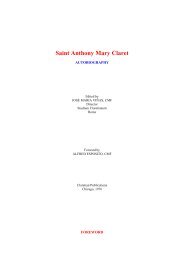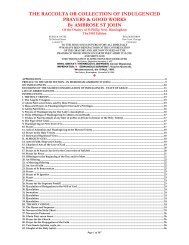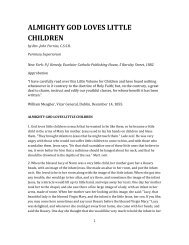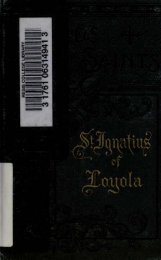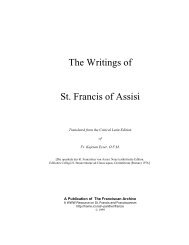the history of heresies, and their refutation - Catholic Apologetics ...
the history of heresies, and their refutation - Catholic Apologetics ...
the history of heresies, and their refutation - Catholic Apologetics ...
Create successful ePaper yourself
Turn your PDF publications into a flip-book with our unique Google optimized e-Paper software.
40. We now come to <strong>the</strong> case <strong>of</strong> Liberius. Constantius had promised <strong>the</strong> ladies <strong>of</strong> Rome that he would<br />
restore him again to his see; but had also promised <strong>the</strong> Eusebians that he would not liberate him till he<br />
communicated with <strong>the</strong>m. He, <strong>the</strong>refore, laid his comm<strong>and</strong>s on Demophilus, Bishop <strong>of</strong> Berea, where<br />
Liberius was exiled, <strong>and</strong> on Fortunatus, Bishop <strong>of</strong> Aquilea, ano<strong>the</strong>r apostate, to leave no means untried to<br />
make Liberius sign <strong>the</strong> formula <strong>of</strong> Sirmium, <strong>and</strong> <strong>the</strong> condemnation <strong>of</strong> St. Athanasius. Liberius was now<br />
three years in exile, broken down by solitude <strong>and</strong> flogging, <strong>and</strong>, above all, deeply afflicted at seeing <strong>the</strong><br />
see <strong>of</strong> Rome occupied by an anti-Pope, <strong>the</strong> Deacon Felix, <strong>and</strong> thus he had <strong>the</strong> weakness to yield, <strong>and</strong><br />
subscribed <strong>the</strong> formula, condemning, at <strong>the</strong> same time, St. Athanasius, <strong>and</strong> communicating with <strong>the</strong><br />
Arian bishops.<br />
<br />
41. It is a question among authors, which <strong>of</strong> <strong>the</strong> three formulas was subscribed by Liberius. Valesius says<br />
it was <strong>the</strong> third; but this has no foundation, for <strong>the</strong> third was not drawn up till 359, <strong>and</strong> St. Athanasius<br />
tells us that Liberius was <strong>the</strong>n after returning to Rome. Blondel <strong>and</strong> Petavius say it was <strong>the</strong> second he<br />
signed, <strong>and</strong> this is <strong>the</strong> general opinion followed by- heretics, who strive thus to prove that <strong>the</strong> <strong>Catholic</strong><br />
Church may fail. The Protestant Danæus numbers Liberius among <strong>the</strong> bishops who joined <strong>the</strong> Arians,<br />
<strong>and</strong> says that all historians are agreed that he signed this formula, <strong>and</strong> after that, he says, no one can deny<br />
that <strong>the</strong> Roman Church can err. But <strong>the</strong> general opinion held by <strong>Catholic</strong>s, <strong>and</strong> which is, also, <strong>the</strong> most<br />
probable, <strong>and</strong> in which Baronius, N. Alex<strong>and</strong>er, Graveson, Fleury, Juenin, Tournelly, Berninus, Orsi,<br />
Hermant, <strong>and</strong> Selvaggi, <strong>the</strong> learned annotator <strong>of</strong> Mosheim, join with Gotti, who gives it as <strong>the</strong> general<br />
opinion <strong>of</strong> <strong>Catholic</strong> authors, is, that it was <strong>the</strong> first formula he signed.<br />
(8) Nat. Alex.; Fleury, I. 13<br />
<br />
There are very weighty reasons to prove that this opinion is founded on fact : First The formula<br />
subscribed by Liberius was <strong>the</strong> one drawn up at <strong>the</strong> time Photinus was condemned, <strong>and</strong> this was,<br />
indubitably, <strong>the</strong> first <strong>and</strong> not <strong>the</strong> second. Secondly <strong>the</strong> formula he signed, <strong>and</strong> which was laid before him<br />
by Demophilus, was not drawn up by <strong>the</strong> Anomeans, or pure Arians, but by <strong>the</strong> Semi- Arians, to which<br />
sect Demophilus, Basil <strong>of</strong> Ancira, Valens, <strong>and</strong> Ursacius belonged. These did not admit that <strong>the</strong> Son was<br />
consubstantial with <strong>the</strong> Fa<strong>the</strong>r, because <strong>the</strong>y would not approve <strong>of</strong> <strong>the</strong> Nicene Creed, but said he was <strong>of</strong><br />
<strong>the</strong> substance <strong>of</strong> <strong>the</strong> Fa<strong>the</strong>r; <strong>and</strong> this was expressed in <strong>the</strong> first formula alone, but not in <strong>the</strong> second, in<br />
which both <strong>the</strong> words substance <strong>and</strong> like unto were omitted. These very bishops even who subscribed <strong>the</strong><br />
first rejected <strong>the</strong> second in a synod purposely convoked in Ancira. Nor does it militate against this<br />
opinion, that <strong>the</strong> formula subscribed by Liberius was also subscribed by <strong>the</strong> Anomeans, for Constantino,<br />
who, as Socrates informs us, favoured <strong>the</strong> Semi-Arian party, obliged <strong>the</strong>m to subscribe to it. Ano<strong>the</strong>r<br />
pro<strong>of</strong> is from Sozymen, who quotes a letter <strong>of</strong> Liberius, written to <strong>the</strong> Semi-Arians, in which he declares,<br />
that those who assert that <strong>the</strong> Son is not like unto <strong>the</strong> Fa<strong>the</strong>r in all things, <strong>and</strong> <strong>of</strong> <strong>the</strong> same substance, do<br />
not belong to <strong>the</strong> Church. From all this it is proved that Liberius signed <strong>the</strong> formula, from which <strong>the</strong><br />
word consubstantiality was omitted, but which approved <strong>of</strong> <strong>the</strong> words substantiality <strong>and</strong> like unto (9).<br />
(9) Tournelly, Theol. t. 2; Blondell. de Primatu, p. 48; Petav. in observ. St. Epiphan.; Danæus, Opus, de<br />
Her.; Baron. An. 357; Nat. Alex., Fleury, Graveson; Juenin, Theol. 40, 3 ques.; Bern in.; Hermant, t. 1; Orsi,<br />
I. 14; Gotti, de Vcr. Rel.; Selvaggi, not. 52, ad Mosh.<br />
<br />
42. Because St. Hilary calls <strong>the</strong> formula signed by Liberius a perfidy, <strong>the</strong> argument is not weakened, for<br />
Noel Alex<strong>and</strong>er supposes, that <strong>the</strong>se words, <strong>and</strong> <strong>the</strong> ana<strong>the</strong>ma hurled against Liberius, in St. Hilary’s<br />
fragments, were foisted in by some o<strong>the</strong>r h<strong>and</strong>, for <strong>the</strong>se fragments were written after <strong>the</strong> return <strong>of</strong><br />
Liberius to Rome, when he most strenuously refused to approve <strong>of</strong> <strong>the</strong> formula <strong>of</strong> <strong>the</strong> Council <strong>of</strong> Rimini;<br />
o<strong>the</strong>rs again, as Juenin, imagined, that St. Hilary called <strong>the</strong> formula perfidious, taking it in <strong>the</strong> perverse<br />
sense as understood by <strong>the</strong> Arians, since speaking <strong>of</strong> it before (considered absolutely in itself), he called it<br />
a <strong>Catholic</strong> formula. Ano<strong>the</strong>r argument is deduced from <strong>the</strong> Chronicle <strong>of</strong> St. Jerome, for he writes, that<br />
Liberius, conquered by a weary exile, subscribed to heretical pravity, <strong>and</strong> entered Rome almost like a<br />
conqueror. Noel Alex<strong>and</strong>er says, that St. Jerome means by this, not that he signed a formula in itself<br />
heretical, but that he communicated with heretics, <strong>and</strong> although <strong>the</strong> communion with heretics was an<br />
error, it was not heresy itself. Ano<strong>the</strong>r answer is, that St. Jerome might have written this under <strong>the</strong> belief<br />
that it was true, since, as Sozymen informs us, <strong>the</strong> heretics spread every where abroad, that Liberius, in<br />
subscribing <strong>the</strong> formula, not only denied <strong>the</strong> consubstantiality, but even <strong>the</strong> likeness <strong>of</strong> <strong>the</strong> Son to <strong>the</strong><br />
Fa<strong>the</strong>r; but, withal, we do not justify Liberius for condemning St. Athanasius <strong>and</strong> communicating with<br />
Page 36 <strong>of</strong> 352



